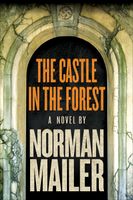07.10: Difference between revisions
(Started adding reviews.) |
m (Tweaks.) |
||
| (6 intermediate revisions by the same user not shown) | |||
| Line 1: | Line 1: | ||
{{WDside}} | {{WDside}} | ||
{{Big|''The Castle in the Forest''. New York: Random House, 23 January. Novel, 477 pp., $26.95.}} | |||
Dedication: | Dedication: “To my grandchildren, Valentina Colodro, Alejandro Colodro, Isabella Moschen, Christina Marie Nastasi, Callan Mailer, Theodore Mailer, Natasha Lancaster, Mattie James Mailer, Cyrus Force Mailer, and to my grand-niece Eden River Alson as well to my godchildren, Kittredge Fisher, Clay Fisher, Sebastian Rosthal, and Julian Rosthal.” | ||
{{cquote|Off hand, I can’t name a serious novel where an Assistant to the Devil is the one to tell the tale, but I found the choice curiously liberating. It allowed me to enter people's minds at will, which is of course one of the strengths of nineteenth-century fiction. You can go into any mind the author chooses to enter, and so are able to live with characters as they appear on the surface, and also as they feel within. Of course, these novels were corseted by nineteenth-century moral strictures. Sexual lines of inquiry were hardly pursued. Now, I did use the third-person omniscient in ''[[The Naked and the Dead]]'', I went into everyone’s head without worrying about it unduly. It never occurred to me that this had become an aesthetic problem. The success of ''The Naked and the Dead'' obliged me, however, to become more sensitive to the improbability of casual omniscience. Obviously, if I was going to keep writing fiction I had to develop a bit. I will say that ever since I have been preoccupied with the problem. I certainly wrestled with it in ''[[The Deer Park]]''. How do you inhabit more than one person's mind? How do you avoid the manacles of the first person observer without violating something ineffable in the presentation? So I was delighted when, behold, I had this Assistant to the Devil ready to tell the tale. Because then you could certainly explore your character's minds, not the least of whom could be young Adolf Hitler.|author={{NM}} |source=[[07.23]]}} | |||
{{ | {{Gallery | ||
|width=200 | |||
|height=200 | |||
|align=left | |||
File:07-10.jpg | |File:07-10.jpg| | ||
</ | }} | ||
<div style="clear:both;"></div> | |||
== Bibliography == | == Bibliography == | ||
{{Refbegin| | {{Refbegin|30em|indent=yes}} | ||
'''Reviews''' | '''Reviews''' | ||
* {{cite magazine |last=Abell |first=Stephen |date=February 16, 2007 |title=The Anality of Evil |url= |magazine=Times Literary Supplement |pages=21–22 |publisher= |access-date= }} Negative. | * {{cite magazine |last=Abell |first=Stephen |date=February 16, 2007 |title=The Anality of Evil |url= |magazine=Times Literary Supplement |pages=21–22 |publisher= |access-date= }} Negative. | ||
* {{cite magazine |last=Coetzee |first=J. M. |date=February 15, 2007 |title=Portrait of the Monster as a Young Man |url= |magazine=New York Review of Books |pages=8–11 |publisher= |access-date= }} Positive. | * {{cite magazine |last=Coetzee |first=J. M. |date=February 15, 2007 |title=Portrait of the Monster as a Young Man |url= |magazine=New York Review of Books |pages=8–11 |publisher= |access-date= }} Positive. | ||
* {{cite news |last=Indiana |first=Gary |date=January 25, 2007 |title=The Devil You Know, The Devil You Don't |url= |work=Village Voice |location= |access-date= }} Positive. | |||
* {{cite news |last=Mallon |first=Thomas |date=January 2007 |title=Portrait of a Young Dictator |url= |work=Wall Street Journal |pages=20–21 |access-date= }} Mixed. | |||
* {{cite news |last=Pritchard |first=William |date=January 21, 2007 |title=Norman Mailer's Fictional Look at the Young Adolf Hitler |url= |work=Chicago Tribune |page=5 |access-date= }} Mixed. | |||
* {{cite news |last=Rollyson |first=Carl |date=January 17, 2007 |title=Mailer: Lost in the Forest in Search of Adolf Hitler |url= |work=New York Sun |location= |access-date= }} Mixed. | |||
* {{cite journal |last1=Ricks |first1=Christopher |date=2007 |title=The Devil Only Knows |url= |journal=Mailer Review |volume=1 |issue= |pages=206–214 |doi= |access-date= }} Positive. | |||
* {{cite magazine |last=Siegel |first=Lee |date=January 21, 2007 |title=Maestro of the Human Ego |url= |magazine=New York Times Book Review |pages=1, 12–15 |publisher= |access-date= }} Positive. | |||
* {{cite news |last=Silman |first=Roberta |date=January 21, 2007 |title=Armies of the Night |url= |work=Boston Globe |location=F6 |access-date= }} Negative. | |||
* {{cite journal |last1=Sipiora |first1=Phillip |date=2007 |title=Moments of Metaphor in Mailer's ''Castle'' |url= |journal=Mailer Review |volume=1 |issue= |pages=228–233 |doi= |access-date= }} Positive. | |||
'''Essays''' | '''Essays''' | ||
* {{cite journal |last1=Fleming |first1=James R. |date=2008 |title='But Where Is the Castle': The Function of Modernist Allegory in Norman Mailer's ''The Castle in the Forest'' |url= |journal=EAPSU Online: A Journal of Critical and Creative Work |volume=5 |issue=fall |pages=143–155 |doi= |access-date= }} | |||
* {{cite journal |last1=Grunzweig |first1=Walter |last2= |first2= |date= |title=The Hitler Family: A Relational Approach to Norman Mailer |url= |journal=Mailer Review |volume=2 |issue= |pages=330–336 |doi= |access-date= }} | |||
* {{cite journal |last1=Whalen-Bridge |first1=John |date=2008 |title='Their Humor Annoyed Him': Cavalier Wit and Sympathy for the Devil in ''The Castle in the Forest'' |url= |journal=Mailer Review |volume=2 |issue= |pages=318–329 |doi= |access-date= }} | |||
{{Refend}} | {{Refend}} | ||
{{1990s|state=collapsed}} | {{1990s|state=collapsed}} | ||
Latest revision as of 08:39, 10 July 2020
The Castle in the Forest. New York: Random House, 23 January. Novel, 477 pp., $26.95.
Dedication: “To my grandchildren, Valentina Colodro, Alejandro Colodro, Isabella Moschen, Christina Marie Nastasi, Callan Mailer, Theodore Mailer, Natasha Lancaster, Mattie James Mailer, Cyrus Force Mailer, and to my grand-niece Eden River Alson as well to my godchildren, Kittredge Fisher, Clay Fisher, Sebastian Rosthal, and Julian Rosthal.”
| “ | Off hand, I can’t name a serious novel where an Assistant to the Devil is the one to tell the tale, but I found the choice curiously liberating. It allowed me to enter people's minds at will, which is of course one of the strengths of nineteenth-century fiction. You can go into any mind the author chooses to enter, and so are able to live with characters as they appear on the surface, and also as they feel within. Of course, these novels were corseted by nineteenth-century moral strictures. Sexual lines of inquiry were hardly pursued. Now, I did use the third-person omniscient in The Naked and the Dead, I went into everyone’s head without worrying about it unduly. It never occurred to me that this had become an aesthetic problem. The success of The Naked and the Dead obliged me, however, to become more sensitive to the improbability of casual omniscience. Obviously, if I was going to keep writing fiction I had to develop a bit. I will say that ever since I have been preoccupied with the problem. I certainly wrestled with it in The Deer Park. How do you inhabit more than one person's mind? How do you avoid the manacles of the first person observer without violating something ineffable in the presentation? So I was delighted when, behold, I had this Assistant to the Devil ready to tell the tale. Because then you could certainly explore your character's minds, not the least of whom could be young Adolf Hitler. | ” |
| — Mailer, 07.23 | ||
Bibliography
Reviews
- Abell, Stephen (February 16, 2007). "The Anality of Evil". Times Literary Supplement. pp. 21–22. Negative.
- Coetzee, J. M. (February 15, 2007). "Portrait of the Monster as a Young Man". New York Review of Books. pp. 8–11. Positive.
- Indiana, Gary (January 25, 2007). "The Devil You Know, The Devil You Don't". Village Voice. Positive.
- Mallon, Thomas (January 2007). "Portrait of a Young Dictator". Wall Street Journal. pp. 20–21. Mixed.
- Pritchard, William (January 21, 2007). "Norman Mailer's Fictional Look at the Young Adolf Hitler". Chicago Tribune. p. 5. Mixed.
- Rollyson, Carl (January 17, 2007). "Mailer: Lost in the Forest in Search of Adolf Hitler". New York Sun. Mixed.
- Ricks, Christopher (2007). "The Devil Only Knows". Mailer Review. 1: 206–214. Positive.
- Siegel, Lee (January 21, 2007). "Maestro of the Human Ego". New York Times Book Review. pp. 1, 12–15. Positive.
- Silman, Roberta (January 21, 2007). "Armies of the Night". Boston Globe. F6. Negative.
- Sipiora, Phillip (2007). "Moments of Metaphor in Mailer's Castle". Mailer Review. 1: 228–233. Positive.
Essays
- Fleming, James R. (2008). "'But Where Is the Castle': The Function of Modernist Allegory in Norman Mailer's The Castle in the Forest". EAPSU Online: A Journal of Critical and Creative Work. 5 (fall): 143–155.
- Grunzweig, Walter. "The Hitler Family: A Relational Approach to Norman Mailer". Mailer Review. 2: 330–336.
- Whalen-Bridge, John (2008). "'Their Humor Annoyed Him': Cavalier Wit and Sympathy for the Devil in The Castle in the Forest". Mailer Review. 2: 318–329.



